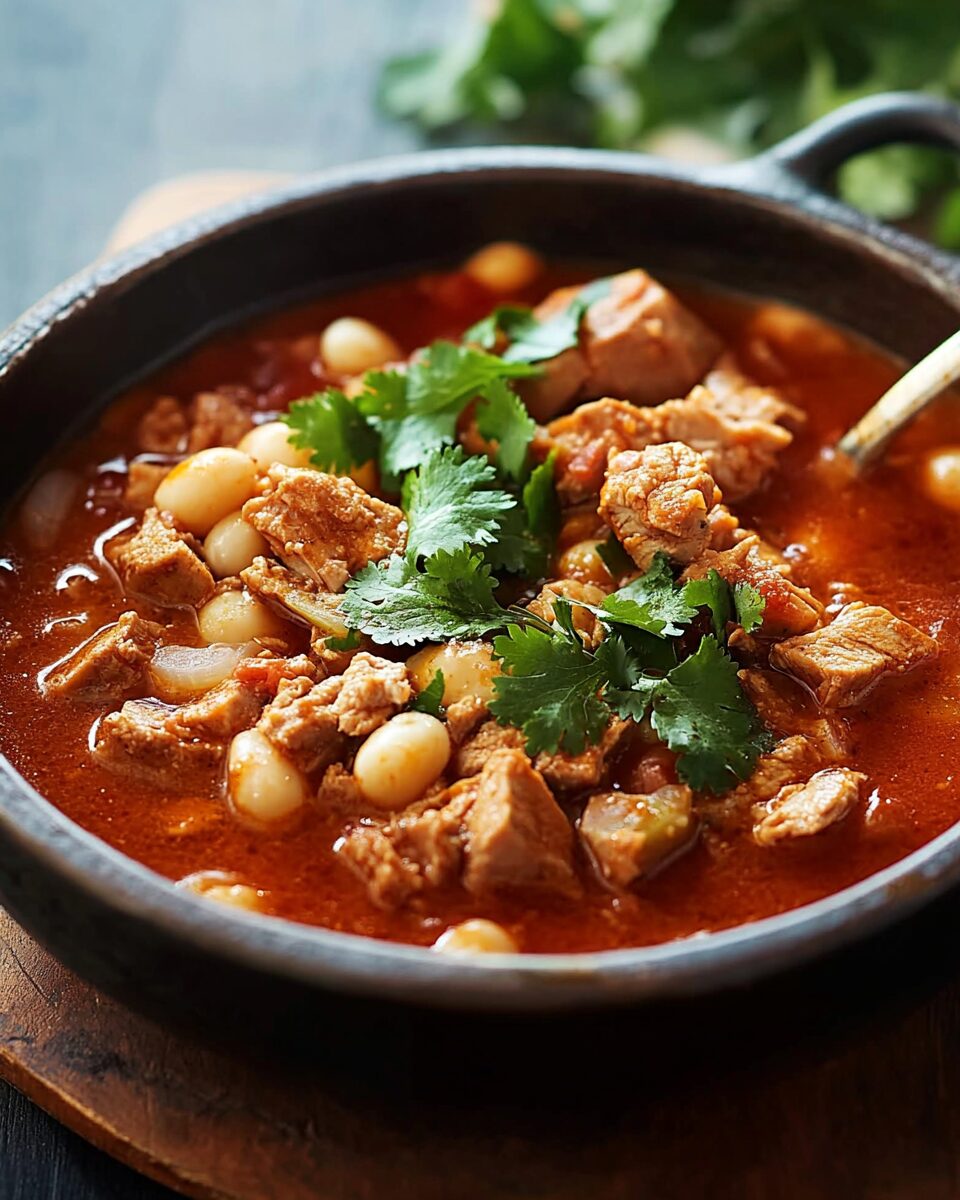Posole Rojo is a rich, comforting Mexican stew made with tender pork, earthy red chiles, and hearty hominy. It’s a deeply flavorful dish that’s perfect for gatherings or cozy dinners, often served with a variety of fresh toppings like cabbage, radish, and lime.
FULL RECIPE
Ingredients
- 4 pounds bone-in pork shoulder, cut into large chunks
- 1 white onion, quartered
- 10 cups water
- 2 teaspoons salt, plus more to taste
- 2 bay leaves
- 1 teaspoon dried oregano
- 6 dried guajillo chiles, stemmed and seeded
- 2 dried ancho chiles, stemmed and seeded
- 4 garlic cloves
- 1 teaspoon cumin
- 2 tablespoons vegetable oil
- 2 (15-ounce) cans white hominy, drained and rinsed
1.Toppings (optional but traditional)
- Shredded cabbage
- Thinly sliced radishes
- Diced white onion
- Fresh cilantro
- Lime wedges
- Dried oregano
- Tortilla chips or tostadas
Directions
- Place pork shoulder, onion, water, salt, bay leaves, and oregano in a large pot. Bring to a boil, then reduce heat and simmer uncovered for about 2.5 hours, skimming foam as needed.
- While the pork cooks, toast the guajillo and ancho chiles in a dry skillet over medium heat for 1–2 minutes until fragrant, being careful not to burn them.
- Transfer the toasted chiles to a bowl and cover with hot water. Soak for 20 minutes until softened.
- Blend the softened chiles with garlic, cumin, and about 1 cup of the soaking water until smooth.
- Strain the chile puree through a fine sieve to remove any solids.
- In a skillet, heat the vegetable oil over medium heat. Add the strained chile puree and cook for 5–7 minutes, stirring frequently, until thickened.
- Once the pork is tender, remove it from the pot and shred or chop it into bite-sized pieces, discarding any bones or excess fat.
- Add the hominy and chile sauce to the pot. Return the pork to the pot as well. Simmer for another 30 minutes to allow flavors to meld.
- Taste and adjust seasoning with additional salt if needed.
- Serve hot with your choice of toppings.
Nutritional Information
- Calories: 450
- Protein: 30g
- Fat: 25g
- Carbohydrates: 30g
- Fiber: 5g
- Sodium: 850mg
- Sugar: 3g
History of Posole Rojo
Posole Rojo has been a part of Mexican cuisine for centuries, with origins that date back to pre-Columbian times. The name “posole” comes from the Nahuatl word “pozolli,” meaning hominy. Indigenous people revered corn as a sacred food, and posole was often prepared for ceremonial events. Over time, the recipe evolved to include pork and other ingredients, and today it’s a favorite dish in many parts of Mexico.
Cultural Significance
Posole rojo is more than just a stew; it’s a dish that brings people together. In Mexico, it’s often served during special occasions like Christmas, New Year’s, and Mexican Independence Day. Families gather to share a pot of posole, creating lasting memories. The dish reflects Mexican values of community, warmth, and tradition.
Common Proteins Used
While pork is the traditional protein in posole rojo, some versions use chicken or beef. Pork shoulder is ideal because it becomes tender after long simmering. Some recipes even include pork ribs, feet, or skin to add flavor and richness to the broth. If you’re looking for a leaner option, chicken can also work well, though it offers a different flavor profile.
Types of Chiles Used
The distinct red color of posole rojo comes from dried chiles. Guajillo and ancho chiles are the most common, providing a mild to medium heat and a deep, smoky flavor. These chiles are toasted and soaked before being blended into a smooth sauce. The choice of chiles is what gives posole rojo its signature taste, but you can adjust the spice level by using hotter varieties if desired.
Cooking Techniques
Cooking posole rojo involves a few important techniques. The pork is simmered slowly to tenderize it, allowing it to absorb all the flavors of the broth. The chiles are toasted to release their oils, then soaked and blended into a sauce. Straining the sauce ensures a smooth texture. These steps may take some time, but the result is a deliciously complex and flavorful stew.
Toppings and Garnishes
Posole rojo is typically served with a variety of fresh toppings. Shredded cabbage adds a nice crunch, while thinly sliced radishes provide a crisp, peppery bite. Diced onions and fresh cilantro brighten the dish, and lime wedges bring a tangy balance to the rich broth. For extra flavor, sprinkle some oregano or crushed red pepper. Tortilla chips or tostadas are often served alongside to add a crispy element.
Serving Traditions
Posole rojo is meant to be shared. It’s often served in large bowls, with a variety of toppings offered on the side. This allows each person to customize their bowl to their liking. Traditionally, the dish is accompanied by cold drinks, like agua fresca, or even a refreshing beer. It’s perfect for gatherings, where everyone can enjoy a warm, comforting meal together.
Health Benefits and Nutritional Value
Posole rojo is a hearty and filling dish. The pork provides a good source of protein and essential nutrients, while the hominy offers fiber and carbohydrates for energy. The toppings, including fresh vegetables, add vitamins and antioxidants. With proper portion control, posole rojo can be part of a balanced diet. The key is to manage the amount of salt and oil used during cooking.
Storing and Reheating
Posole rojo keeps well in the refrigerator for a few days, and it often tastes even better the next day as the flavors continue to meld. If you have leftovers, you can freeze them for later. When reheating, it’s best to do so gently on the stove to avoid overcooking the pork. Be sure to store the toppings separately so they stay fresh.
Pairing Suggestions
Posole rojo pairs wonderfully with a variety of side dishes. A refreshing cucumber salad, pickled onions, or fresh fruit complement the richness of the stew. For drinks, a light Mexican lager or agua de tamarindo can balance the flavors. To finish the meal, consider serving a sweet dessert like flan or churros.
Making Posole Rojo Ahead of Time
Posole rojo is an excellent dish to make ahead. You can cook the pork and broth in advance, then add the hominy and chile sauce just before serving. This makes it a convenient meal for busy days or for special occasions when you want to spend less time in the kitchen. The flavors actually improve when the dish is allowed to rest.
Vegetarian and Vegan Adaptations
If you’re looking for a vegetarian or vegan version of posole, it’s easy to swap the pork for plant-based alternatives. Mushrooms or jackfruit can provide a similar texture, while vegetable broth replaces the pork broth. The chile sauce remains the same, ensuring the dish keeps its authentic flavor. With a few simple substitutions, you can enjoy this beloved dish without meat.
Instant Pot and Slow Cooker Methods
If you’re short on time, you can prepare posole rojo using an Instant Pot or slow cooker. The Instant Pot can cut down on cooking time significantly while still delivering tender pork. A slow cooker is ideal if you prefer a hands-off approach; just let it cook slowly over several hours for a deeply flavorful stew.
Common Mistakes to Avoid
When making posole rojo, there are a few common mistakes to watch out for. Overcooking or under-seasoning the pork can lead to bland results. Straining the chile sauce is important to achieve a smooth texture. Also, be sure to rinse the hominy well before adding it to the stew to avoid a tinny flavor. Paying attention to these details will ensure a better dish.
Making it Spicier or Milder
Posole rojo’s spice level can be adjusted based on your preferences. To make it spicier, try adding extra chiles or a dash of hot sauce. If you prefer a milder stew, reduce the amount of chiles or omit the spicier varieties. Serving the dish with hot sauce on the side allows each person to control the level of heat to their taste.
Kids and Family-Friendly Modifications
For families with young children, consider making a milder version of posole rojo. You can reduce the number of chiles used and serve the spice on the side. The toppings—like cabbage and radishes—add fun and texture, making it a dish kids will enjoy. It’s also a great way to introduce children to new flavors in a more approachable way.
Conclusion
Posole rojo is a dish steeped in tradition, culture, and flavor. Whether served at a family gathering or made for a quiet dinner, it brings people together. The combination of tender pork, hearty hominy, and flavorful chiles creates a warm, comforting meal. With endless variations and opportunities for customization, posole rojo remains a timeless Mexican favorite that continues to delight.






